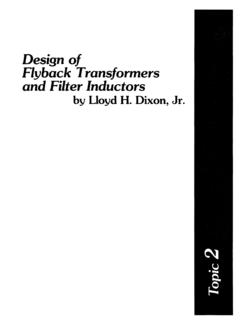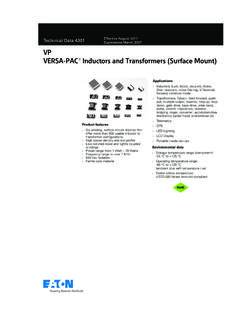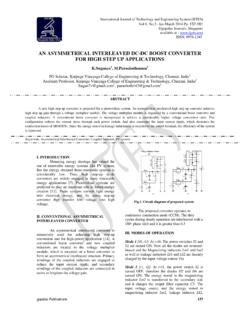Transcription of Inductor and Flyback Transformer Design' - TI.com
1 Section 5. Filter inductors , boost inductors and Flyback transfonners are all members of the "power Inductor ". family. They all function by taking energy from the electrical circuit, storing it in a magnetic field, and subsequently returning this energy (minus losses) to the circuit. A Flyback transfonner is actually a multi- winding coupled Inductor , unlike the true transfonn- ers discussed in Section 4, wherein energy storage is undesirable. Application Considerations Design considerations for this family of inductors vary widely depending on the type of circuit applica- tion and such factors as operating frequency and rip- ple current. Inductor applications in switching power supplies can be defined as follows (see Fig.)
2 5-1): .Single winding inductors : Output filter Inductor (buck-derived). Boost Inductor Flyback (buck-boost) Inductor Input filter Inductor .Multiple winding inductors : Coupled output filter Inductor (R5). Flyback Transformer Inductor design also depends greatly on the in- ductor current operating mode (Figure 5-2): Design limitations: The most important limiting .Discontinuous Inductor current mode. when the factors in Inductor design are (a) temperature rise and instantaneous ampere-turns (totaled in all wind- efficiency considerations arising from core losses and ings) dwell at zero for a portion of each switching ac and dc winding losses, and (b) core saturation.
3 Period. Output filter inductors (buck-derived) --single .Continuous Inductor current mode. in which the and multiple windings are seldom operated in the total ampere-turns do not dwell at zero (although discontinuous current mode because of the added the current may pass through zero). burden this places on the output filter capacitor, and because it results in poor cross-regulation in multiple In the continuous current mode, the ripple current output supplies. Typically operated in the continuous is often small enough that ac winding loss and ac core mode with peak-peak ripple current much smaller loss may not be significant, but in the discontinuous than full load current, ac winding loss is usually not mode, ac losses may dominate.
4 Significant compared to dc loss. 5-1. design is then usually limited by dc winding losses and core saturation. However, many boost and Flyback applications are designed to operate in the discontinuous mode, because the required inductance value is less and the Inductor physical size may be smaller. But in the dis- continuous mode, the Inductor current must dwell at zero (by definition) during a portion of each switch- ing period. Therefore, the peak of the triangular cur- rent waveform, and thus the peak-to-peak ripple must be at least twice the average current, as shown in Fig. 5-2(a). This very large ripple current results in a po- tentially serious ac winding loss problem.
5 Also, the resulting large flux swing incurs high core loss. Core loss then becomes the limiting factor in core utiliza- tion, rather than saturation, and may dictate a larger core size than otherwise expected. Thus, the circuit designer's choice of operating mode makes a substantial difference in the Inductor design approach. When Flyback transformers are operated in the continuous Inductor current mode, the total ampere- turns of all the windings never dwell at zero (by defi- nition). However, the current in each winding of any Flyback Transformer is always highly discontinuous, For example, assume full load Idc of 10A, and regardless of Inductor current mode.
6 This is because typical peak-peak triangular ripple current 20% of Idc, current (ampere-turns) transfers back and forth be- or 2A (worst at high Vin). In this example, the worst- tween primary and secondary(s) at the switching fre- case rms ripple current is (triangular wave- quency. As shown in Fig. 5-3, the current in each winding alternates from zero to a high peak value, form rms equals I pp / .Jj2 ), and rms ripple current even though the total ampere-turns are continuous squared is only .333, compared with the dc current with small ripple. This results in large ac winding squared of 100. Thus, for the ac f R loss to equal the loss, regardless of the operating mode.
7 Dc loss, the RajRdc ratio would have to be as large as However, the core sees the total ampere-turn 300 (Section 3, Fig. 3-5). This is easily avoided. ripple. Thus, core loss behaves in the same manner as Therefore, ac winding loss is usually not significant. with the single winding Flyback Inductor discussed Also, the small flux swing associated with small previously- small core loss when designed and oper- ripple current results in small core loss, with high ated in the continuous mode, large core loss in the frequency ferrite core material operating below discontinuous mode. 250kHz. Core utilization is then limited by saturation (at peak short-circuit current).
8 However, the small flux swing may permit the use of lossier core materi- als with higher BSAT,such as powdered iron, Kool- mu@, or laminated metal. This may enable reduced cost or size, but core loss then becomes more signifi- cant. Also, distributed-gap materials exhibit rounding of the B-H characteristics (Sec. 2, pg. 2-3), resulting in decreasing inductance value as current increases. Boost and input filter inductors and single winding Flyback inductors are often designed to operate in the continuous mode. As with the buck- derived filter inductors described previously, Inductor 5-2. Losses and Temperature Rise dered metal cores, the winding(s) should be likewise distributed.
9 Thus, a toroidal core shape should have The discussion in Section 4 regarding tempera- the windings distributed uniformly around the entire ture rise limits, losses and thermal resistance in trans- core. formers (pp 4-1,2) is generally applicable to induc- With a discrete gap, used with laminated metal tors, as well. alloy cores or ferrite cores, the winding should be Balancing Core and Winding Losses directly over the gap. For example, if a pair of "C". When inductors are designed for the discontinu- core halves has a gap in one leg and the winding is ous mode, with significant core loss, total loss is at a placed on the opposite (ungapped) leg, as shown in broad minimum when core and winding losses are Fig.
10 5-4a, the entire magnetic force introduced by the approximately equal. But when inductors are de- winding appears across the two core halves. This re- signed for the continuo~s mode, core loss is often sults in considerable stray flux propagated external to negligible, so that the t~talloss limit can be allocated the device, in addition to the flux through the gap. entirely to the windings. The energy stored in the external stray field can eas- General Considerations --Core ily equal the energy stored in the gap, resulting in an inductance value much greater than expected. The Ideal magnetic materials cannot store energy. external stored energy is difficult to calculate, making Practical magnetic materials store very little energy, the total inductance value unpredictable.












